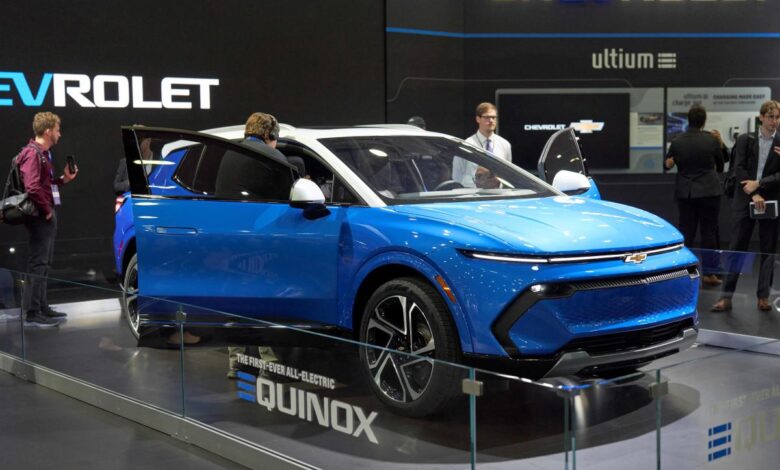
[ad_1]
For driving enthusiasts, electrification is a dirty word.
But when it comes to decarbonizing the earth’s atmosphere, the ability to harness clean energy, and simplifying the production process for automobiles, it’s no surprise automakers and governments across the globe were eager to jumpstart the dream of an electric vehicle transformation.
The past year was supposed to be a big year for that transformation in the US. But a number of factors led to a sobering reality: The process of converting the nation’s vehicles to electric power was going to be a much longer one.
Sure, research firm Kelley Blue Book reported that US EV sales in the third quarter crossed 313,000, nearly a 50% increase from a year ago, with EV market share hitting 7.9% — its highest-ever level. But that growth rate is slowing, and seems to be headed to a 10% rate where it might remain for some time. Though places like California are seeing 20% adoption rates, in other states the rate is barely registering.
A combination of factors like high prices for EVs, higher finance costs, and infrastructure issues dimmed prospects for an EV transformation in America, though there’s still reason for some optimism in 2024.
‘A great product is not enough’
Ford (F) CEO Jim Farley, one of the biggest evangelists for EVs among legacy automaker execs, warned things needed change. “A great product is not enough in the EV business anymore. We have to be totally competitive on cost,” he said following the release of the company’s Q3 earnings in October.
And he wasn’t the only one warning about high prices of EVs compared to gas-powered equivalents.
“I’m worried about the high interest rate environment we’re in,” Tesla (TSLA) CEO Elon Musk said following the EV maker’s Q3 earnings release, adding, “I just can’t emphasize enough how important cost is … we have to make our products more affordable so people can buy [them].”
Ford, along with Tesla and GM (GM), recently paused billions’ worth of investments in EV projects until capacity is needed. Ford said in its earnings report that US EV buyers were “unwilling to pay premiums for [EVs] over gas or hybrid vehicles, sharply compressing EV prices and profitability.”
Ivan Drury, Edmunds’ director of insights, told Yahoo Finance: “In 2023, Americans grappled with elevated living costs and surging interest rates, leading to a notable shift toward more budget-friendly new vehicles … this shift has adversely affected the demand for higher-priced EVs. With early adopters among a wealthier demographic sufficiently addressed, EVs now face the challenge of appealing to the mass market.”
With that higher-income buyer already satisfied, Drury said the broader mass market has practical requirements like more charging stations, vehicle range, and lower prices.
When asked what concerns them most about buying an electric vehicle, 77% of respondents in a Yahoo Finance/Ipsos poll conducted in the fall were worried about a lack of charging stations on the road or charging at home, 73% were concerned about driving range, and 70% noted overall cost.
SAP Mobility analyst Bill Newman echoed these concerns. “I think what you’re going to find is that to get to that next level, [buyers] are going to look to things like battery density to eliminate range anxiety, and try to find some additional electric vehicle charging stations and networks.”
Edmunds’ Drury also believes a dearth of products, especially cheaper EVs, was a problem.
“The stagnation in EV market share in the latter half of 2023 can be attributed in part to the absence of high-profile new EV launches that typically fuel significant awareness and interest,” he said.
What 2024 may have in store
Analysts see some signs of hope in 2024 for EV adoption, though bumps on the proverbial road are expected too.
“While EV sales are anticipated to rise in 2024, the hurdle of achieving mass-market affordability poses a significant challenge to widespread EV adoption goals,” Edmunds’ Drury said. “Presently, the EV adoption curve is more likely to resemble a jagged lightning bolt than a smooth curve.”
One factor that could boost EV sales in 2024 is a change in how the federal EV tax credit of $7,500 is administered. Currently the tax credit is received after a buyer files their tax return the following year, however those rules are changing, allowing for a “point of sale” credit where a buyer can transfer the credit to the dealer immediately, lowering the price of the EV at purchase time.
That could be a big boon to price-conscious buyers. But as we know, when the government gives, it can sometimes take away. And that will be the case in 2024 when more stringent battery component sourcing rules come into play. Some cars like the Tesla Model 3 and Ford Mustang Mach-E will lose the credit temporarily as automakers adjust their supply chains for more domestic battery parts.
Nonetheless, cheaper EVs are coming, and regardless of tax credit status that will help overall EV sales in new year.
“I think you’re going to see [EVs] pushing into that [pricing] midrange … so now as we start to push in, keep an eye on GM’s Equinox, right? Depending on what kind of luxury I want, I can push into that for under $40,000. Now you’re making that available,” SAP’s Newman said about GM’s upcoming entry-level EV.
And don’t forget about interest rates, Newman added — and how the Federal Reserve manages rate cuts next year.
The pricing effect is very real, and has been trending in the right direction for consumers. Kelley Blue Book finds that in November the average transaction price (ATP) for a new EV was $52,345, down from about $65,000 a year ago, with Tesla ATPs dropping nearly 21% compared to a year ago.
“In recent months, price parity between EVs and ICE has almost seemed possible,” said Stephanie Valdez-Streaty, director of strategic planning at Cox Automotive (Kelley Blue Book’s corporate parent) in a November report. “It is a complicated measure with plenty of variables, but newer products and higher discounts have brought down average EV prices, even before potential tax incentives. A year ago, the EV premium was more than 30%. Today, it’s less than 10%.”
Pras Subramanian is a reporter for Yahoo Finance. You can follow him on Twitter and on Instagram.
Click here for the latest stock market news and in-depth analysis, including events that move stocks
Read the latest financial and business news from Yahoo Finance
[ad_2]
Source link




